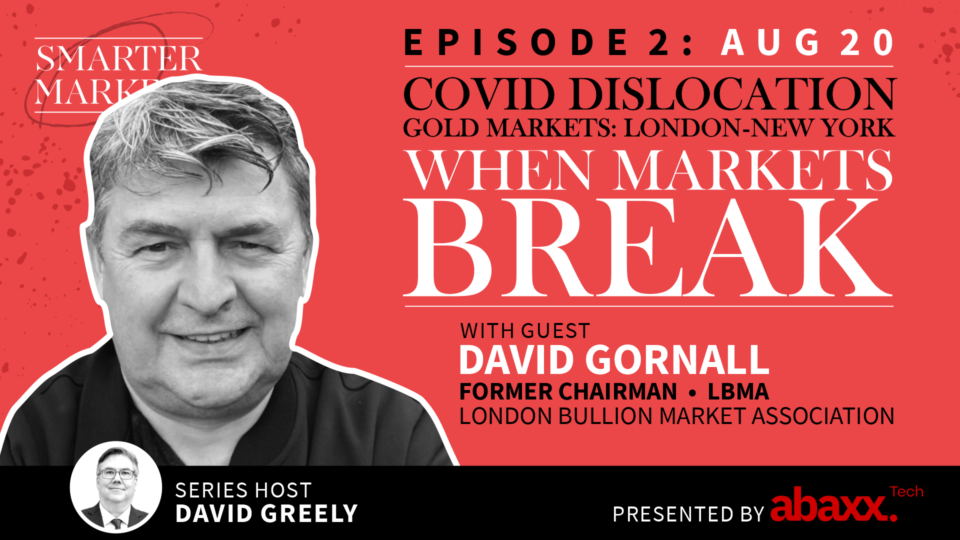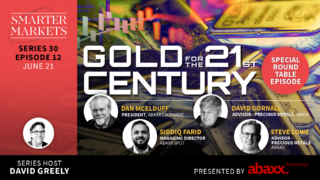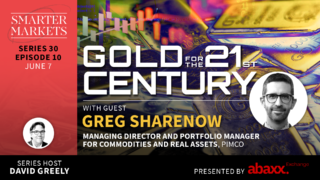In this episode, SmarterMarkets™ host David Greely welcomes David Gornall, the former Global Head of Precious Metals Trading at Natixis and Former Chairman of the London Bullion Market Association (LBMA).
Together, they discuss the massive dislocation between the gold markets in New York and London in March 2020 during the early days of the COVID-19 lockdown.
Hosted By
Episode Q&A
The following Q&A is created using slightly edited excerpts from the episode transcript, optimized for readability. Download full transcript.
DG: Well, we should say that the new premium over London has always been a few cents and sometimes a few dollars an ounce. So for the market to move up to $67, this was a seismic move that the risk of this differential, or which we call the EFP, was modeled to be around a dollar, or say a dollar and half, and stress tested to around five. The other important aspect of the gold market is that the physical over-the-counter spot market is in London, and the futures market is in New York. What we’ll see as a physical gold that’s held in London, typically hedged with a short futures contract deliverable in New York. There are good reasons why this is the preferred hedge mechanism of a physical trader. First of all, the futures offer a price spread that’s narrow, stable, and often yields a better forward contango than London OTC forwards. The exchange age also removes the OTC bilateral credit risk that an OTC trade carries, as the differential widens, anyone with a short hedge was getting squeezed. So the exchange margin calls would force banks to decide on whether to maintain the short, pay the margin and try and deliver or close out and pay the loss.
To evaluate the vulnerability, we should define this part of the market structure as five risk factors. The location difference, which translates to your logistical risk. The size of the barrage you mentioned in each market – we call that the fungibility risk of metal. The next thing is expert physical trading knowledge. Then there are exchanges, internal position limits, and then you’ve got the bank’s own risk appetite and limit. So there are five things that all play out. At various times during this dislocation, at least one of these factors prevailing to affect the price. And that it’s high, all five of them played a part in the story. One thing about the peculiarity of having a physical spot market in London and futures contract deliverable in London is this inter-deliverability factor.
The relocation of gold from predominantly Swiss refineries was prevented by a ban on passenger flights globally at the time. The other issue was the size of the bar. So in New York, it’s a 100-ounce bar that’s deliverable. Whereas the size of the bar traded in London is 400, and they’re not into deliverable. Apart from the existing stock that sits on exchange, any new 100-ounce or kilo bar must be produced to order. So from a refiner’s perspective, this is a just-in-time premium variety of gold, so you won’t usually find them lying around in volts, waiting to be traded, and so there are about five refineries in Switzerland; there may be eight in total, globally that regularly cast and deliver eligible exchange bars. The other aspect of this was two types of participants in the market.
The physical trades largely trade both markets of London and New York separately, but they’ll also trade both at the same time using an AFP, which is a single trade that simultaneously, in this example, buyers, futures, and sales London at a market rate that represents the price difference between the two. Then there are the financial electronic traders who trade fudges in New York and won’t hedge by trading OTC London. In most cases, the financial futures traders weren’t set up to trade the EFP with the OTC physical market. So when they were caught with shorter futures, they were only left with one option. They could only buy back their futures position on the exchange and thus driving the price higher. So physical hedges would normally close out their risk of London and New York by buying the EFP.
It’s a trade that simultaneously involves the purchase of the exchange in the sale of OTC or vice versa, at a rate differential in US dollars per ounce. So, you can buy the futures and sell the OTC in one trade or contract.
Yes, because it avoids leg lifting. So rather than having to go on and trade, if you have a physical trade, you are allowed to put it onto the exchange under the exchange rules. This means you can eliminate the risk between the two markets without going through two venues.
Yes. I mean, you’re not going to remove the two sets of fees on it, but it’s certainly removing the price differential risk that you’re going to run while you decide whether you are going to do the futures or the OTC.
For most people sitting there, watching this unfold, there wasn’t any correction; bid followed bid. So as the futures became bid and the prices rose, the electronic futures market makers chased the price higher. We’ve talked about how the futures traders didn’t use the EFP to liquidate their shorts. So if they did use the EFP, they wouldn’t have chased it as high. However, the FP market did become a liquid and probably wouldn’t help them in the end. But, the result was that the new futures prices rose much quicker than the London spot. As for the supply, without adjusting time, stock of hundred-ounce bars or kilo bars, and no refiner is open at the time to create them. The market was left traveling in one direction at a velocity.
If you had been fortunate enough to hold eligible material at one of the refineries, you could have thought you were in a better position, but then there were no flights. So one of the things that people don’t really know about the gold market is that gold isn’t moved around in a commercial way that is on freighters. They sit in the cargo hold of passenger aircraft. And if you’re traveling between gold hub to gold hub, you may well be sitting on a pile of gold underneath you, and that’s the way it’s moved. So when that mode of transport dried up, so was the ability to deliver gold from hub to hub. And after that, when things reopened in the refineries, we had this mass of flight bookings.
And so we ran out of capacity because of how much gold fits on an aircraft. With many airlines not moving passengers around, they quickly turned these planes into cargo planes. I’ve seen some pictures where they simply put them on the seats and stacked them neatly in places people usually would’ve been, which helped alleviate some of the problems. But in reality, the banks got caught with the short hedge and the negative variation margins, which ranged between several hundred million and a billion, according to what they stated publicly, such as the size of their market losses. They were huge in magnitude, probably six to seven standard deviations away from any market risk model. So we can say it was a Black Swan event. It definitely undermined the ability to manage market price risk by using this method of futures hedging versus London gold holdings.
Once they’d overcome the two of those five risks, you would’ve thought then it was plain sailing after there. So then, we introduced the other three risks which are the risk models, and the knowledge or ability to deliver, those were the limits. We mentioned that some participants that had delivered gold in that delivery month, reached their exchange limit. So the exchange place a limit on what you can deliver during the active month. And you weren’t allowed or able to make a second one. There were some exemptions permitted, but they weren’t the norm. The second problem was overcoming those obstacles. Some of the traders had metal in the right place, on the right side of the Atlantic, had the position limits, and were about to pull the trigger.
And they were prevented from doing so by their risk managers, who said that this was creating more risk. And they were told to take the hedge off, move the goal back to an OTC vault, and don’t put anymore onto the exchange. So whilst people have thought that they’ve got the upper hand in this arbitrage, they hadn’t quite got it. There was another frustrating one that hadn’t been accustomed to delivering metal to exchange that; it’s quite a nuanced process. And if you haven’t done it before, you realize that you need an experienced person to complete the transfer efficiently in the timeframe allowed. Because no one’s going to help you to figure it out in a short timeframe. So we have a perfect storm.
It was shipped back to London because of the model factor. There’s always a number that a risk manager uses to say, what is fair value? So if you’re going to measure this differential and it’s only ever traded between $1 and $5 over the last 50 years, then that’s the number you’ll use. But if it throws out a $70 differential, it breaks all the dials on the dashboard. There’s no way of resetting it. A lot of these models are looked at regressively and they look at it over a period of time. So once it breaks, it doesn’t just break for that day or that month. It stays within the risk, sometime, for a year or two years thereafter until it levels out. It has some long term implications for the futures market.
Let’s look at the wider gold market. It wasn’t just London and New York that was affected by this. In China there was the largest discount ever seen to London. So from New Yorkit was monumental and the same was going on in India. You have to realize what the Western mantra is to hoard gold in times of turmoil. It’s the rainy day fund. Whereas the Asians tend to use gold in that time. Where there is turmoil, they tend to dishold and then they go to cash. This was their rainy day, and so they’re cashing out. And the opposite effect is happening. So you’ve got massive discounts in China and India and didn’t explore before somebody said why don’t you just connect those two, they have to remain within the country. And that’s probably one of the reasons why they went to an even deeper discount. In terms of broader, precious metals, we saw the same differentials occurring in silver and platinum, all the way down the supply chain to the coin market. We ended up around a hundred dollars premium. It wasn’t just London, New York. That was just one example of how the dislocation happened.
It’s not quite the same thing because the standards are very similar. You can move bars, but you don’t put silver on an aircraft when it’s $20 an ounce. Typically, you would ship silver by sea freight container and that’s when you can find them. We’ve all heard about the problems of supply chain management for a lack of vessels, a lack of containers and so silver got caught up in that very typical supply chain problem, even though the bars with the same size in London as they were in New York.
I think the answer to that was it happened in increments over a period of time. We’ve got the active futures months. So it did take a few months to unwind and when gold did start to flow into exchange at the end, we actually saw temporarily a discount to London, but that didn’t last very long. The answer is that it did resolve itself, as the four of the five main risks became manageable. Did the regulators get involve? Not really. CME is a self-regulatory organization and they were creating another delivery point in London for 400 ounce bars, but that contract was new and it wasn’t inter deliverable with the hundred ounce liquid futures contract, so it really didn’t have too much of an effect. Together, the traders and the risk managers thought it was more prudent to keep some gold in New York from now on. Certainly it’s the case when some traders keep more gold in New York than they ever did before.
Risk managers have longer memories than traders do. I think the traders were looking forward to getting back on the horse and do business as usual, but the risk manager’s never going to let them forget it. So the answer is that there’s a lot more prudence involved in managing those risks and positions. Many people did question this whole structure of the market and how it came to be and it led people to think about how to build a more fungible global system of liquidity, not just one in London, but in multiple delivery points. But as the market corrected itself, a lot of people lost interest in trying to find a long term resolution, it was just too hard to do. That idea got put on the back burner. Will it come back again? Maybe.
The two things I’ve noticed, aside from the reduction in limits, was the greater use of forward London hedging. Whilst some believe that the futures is a much more efficient way of hedging because of its liquidity, simplicity and lack of counterparty risk. The alternative way was to go back to OTC forward hedging, that’s what we’ve seen when we look at the trade data. The 6 million ounce daily average of forwards and swaps on gold in London, after this event, became 10 million and it remained 10 million. I think, it’s still the same today and it had peaks of 15, 20 million ounce. What it means is that the system of using futures to hedge physical isn’t as widely used as it was before the dislocation event.
It’s not for one person to say what they would change, it’s for one person to listen to what everybody else would like to see. I think people would like to see a bigger and more developed gold market. I think they’d like to see the local centers being more included rather than acting as outlying hubs. The synergy is a global market rather than having outliers, and you’ll get more connectivity, you pull more liquidity, and that’s what everybody wants at the end of the day. Nobody wants to deal in a pool of liquidity that evaporates as this differential did in 2020. The deepest pool of liquidity will always win. It’s really up to the users of the market to come up and design their own future proof system that allows everybody to have access and to remove some of the barriers that we’ve seen in these examples, that can be very disruptive to the market.







